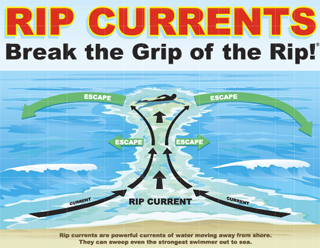Date Posted: May 31, 2013

All of a sudden we couldn't touch the bottom. We tried to swim but couldn't… It took a bit to realize we were in a rip current. The waves kept breaking over my head and I was getting tired. I started to panic.
Rip currents are powerful currents of water moving away from shore. They can sweep even the strongest swimmer out to sea. Annually, rip currents claim the lives of more than 100 people.
Rip Current Awareness Week, June 2-8, 2013, is an opportunity to learn how to avoid this dangerous phenomenon. Respect the power of the ocean and stay safe this summer. Here are tips to avoid rip currents and other beach dangers.
Always swim at a lifeguard protected beach
- When you arrive at the beach, check with the lifeguard about surf conditions and rip currents before going into the surf zone. The lifeguard knows where the rip currents are and other surf hazards as well. This information could save your life.
- Obey the lifeguard, posted rip current and beach hazard signs.
- Learn the meaning of the beach warning flags and obey them.
- Annually, America’s surf beach lifeguards rescue more than 50,000 swimmers from rip currents. Swim near the lifeguard. According to the United States Lifesaving Association, your chances of drowning on a beach patrolled by a lifeguard is 1 in 18 million (beach visits).
- Always watch your children carefully, especially when they are playing near the edge of the ocean or in it. A sudden wave or current could quickly drag them through the surf out to the breaking waves. Remember, a child can drown in seconds.
Learn how to swim in the ocean
- Eighty per cent of all beach rescues are related to rip currents.
- Before going in, learn how to swim, and not just in a swimming pool. Swimming in a pool is NOT the same as swimming at a surf beach with crashing waves, winds, and currents that can change suddenly.
- You should be a strong swimmer before going into the ocean, Great Lakes, or Gulf of America.
- Swimming in currents and waves is much more difficult than swimming in a pool. You will fatigue more quickly than swimming in a pool.
- Enter the water feet first. Diving into breaking waves is dangerous. You don’t know how deep the water is, there might be a sandbar just beneath.
- Respect the power of the ocean! Remember! NEVER turn your back on the ocean. Ocean waves can hit you suddenly causing severe neck and spinal cord injuries.
Learn how to identify rip currents
- Rip currents are channelized currents of water flowing away from shore at surf beaches. Typically they form at breaks in sandbars, and also near structures, such as jetties and piers.
- Rip currents are common and can be found on most surf beaches, including the Great Lakes and Gulf of America.
- Some clues that a rip current is present are: a channel of churning, choppy water; a difference in water color; a line of foam, seaweed or debris moving seaward; a break in the incoming wave pattern.
- This break in the incoming wave pattern can look like smooth safe water. This is actually the rip current knocking down the incoming waves as this river of water returns to the ocean.
Know what to do if caught in a rip current
- Stay calm.
- Don’t fight the current.
- Escape the current by swimming in a direction following the shoreline. When free from the pull of the current, swim at an angle away from the current toward shore.
- If at any time you feel you will be unable to reach shore, draw attention to yourself: face the shore, call or wave for help.
- Have a buddy or two on the beach watching you, should you need help, they can quickly get help.
Make your beach excursion a safe one. Always swim at a lifeguard protected beach, respect the power of the ocean, learn how to identify rip currents and know what to do if caught in one. These simple lessons will keep your family safe this summer.
For More Information
Rip Current Safety
Help NOAA spread the word about rip current safety. Get handouts, brochures and safety tips for kids.
Beach Hazards
While the beach is beautiful, it can also be dangerous. Jellyfish, extreme heat, tsunamis and sharks are all possible beach hazards. Learn what you can do to stay safe.